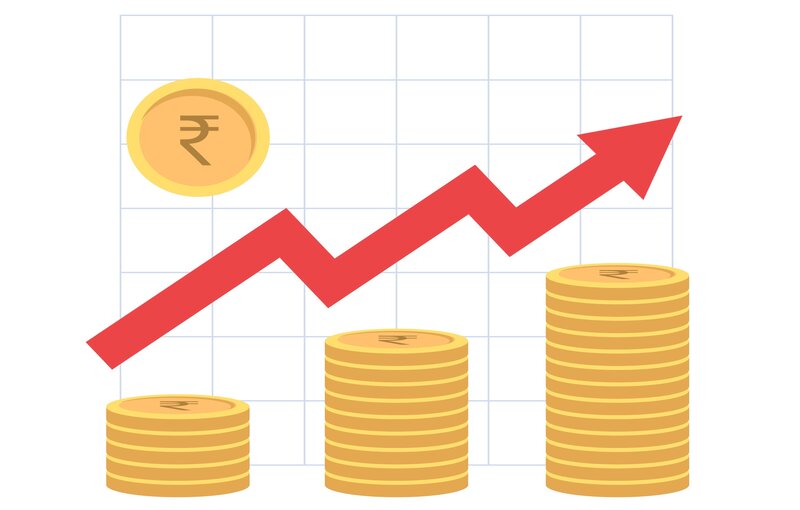How market linked products are better than fixed interest products for wealth creation

Household savings composition in India
Indian retail investors have traditionally favoured fixed interest products over market linked products even though our financial industry has evolved a lot over the past 25 – 30 years. As per RBI Bulletin on Financial Assets and Liabilities of Households (September 2021), bank deposits comprise 53% of household financial assets. Investments in life insurance plans comprise 24% of household financial assets. As vast majority of these investments would be in traditional plans (non unit linked); as per IRDA annual report for FY 2020 - 21, 85% of the premiums in FY 2021 were for non unit linked plans. Investments in mutual funds accounted for nearly 10% of household financial assets (as per RBI, September 2021).
Though percentage of household financial assets invested in mutual funds may seem quite low, this percentage used to be much lower a few years back. As on July 2022, assets under management in mutual funds from retail and HNI investors stood at Rs 17 lakh crores (source: AMFI).
However, if we compare our investments in market linked products with developed markets like the United States, then we are lagging far behind. In this US, more than 50% of households have investments in mutual funds. In India, not only do a lesser percentage of our households invest in mutual funds, but even in the households investing in mutual funds, a smaller percentage of their savings are invested in mutual funds.
In this blog post, we will discuss how capital market linked investments are better than fixed interest/coupon investments for investing and creating wealth.
What is the difference between market linked and non market linked investments?
Market linked products invest in capital market instruments like stocks and bonds. There is no assurance of capital safety or guaranteed returns in market linked investments. Your returns in such products will be market linked and subject to market risks. Examples of market linked products are mutual funds, unit linked insurance plans (ULIPs), portfolio management services (PMS) etc.
Non market linked products usually have fixed terms or tenures. These products are not subject to market risks and the maturity amount in such products is predictable to a certain extent. Examples of non market linked products are bank fixed deposits (FD), Government small savings schemes, traditional life insurance plans, company fixed deposits etc. These products have explicit or implicit assurance of capital safety. For example, in a Bank FD you are assured that you will get the principal amount. Similarly, in a traditional life insurance plan you know you will get the sum assured on maturity. Most of these products also have explicit or implicit guaranteed returns. For example, in an FD you will get a fixed interest rate over the term of the deposit, in traditional life insurance plan, you may get Guaranteed Additions.
You should know that not all non market linked investments give guaranteed returns. Public Provident Fund (PPF) interest rates are subject to revision by the Government every quarter. Similarly reversionary bonuses paid by life insurance plans are not fixed; it depends on the bonus declared every year by the insurance company. You should understand how an investment pro
Interest rates have been declining
The returns of the non-market linked or fixed interest products are linked with the interest rates in our economy. The chart below shows the FD interest rates of major public and private sector banks over the past 20 years or so. You can see that interest rates have generally been declining. This is no surprise based on historical interest rates of major economies. As an economy grows, inflation and interest rates will fall in the long term. As the Indian economy grows, the interest rates are likely to decline further in the future.

Source: Bajaj Finserv (as on 31st March 2022). Disclaimer: Past performance may or may not be sustained in the future.
Why market linked investments give higher returns?
As per finance theory, risk and returns are related. Let us understand this concept by comparing a bank FD with a non-convertible debenture (NCD) or corporate bond. Suppose a 5 year Bank FD is giving 5.25% interest rate per annum. A company issuing a 5 year NCD, will have to pay higher interest rate or coupon compared to Bank FD. If the company does not pay higher interest rate than bank FD, why will you invest in the NCD? The issuer is paying you higher interest rate because you are taking the risk. Not all NCDs will have the same interest rate or yield. An issuer with a lower credit rating will pay you even higher interest rate, compared to an issuer with higher credit rating. Why will you invest in a lower rated bond unless it gives higher returns? Higher the risk, the higher will your returns be. You should understand the risk return trade-off and make informed decisions, based on your risk appetite. In general, the interest rate of a risk free investment will be only slightly higher than the inflation rate. A market linked investment will usually give higher returns than a fixed interest investment. We will discuss a few examples in the following sections. Let us now compare returns of fixed interest and market linked products of similar tenures.
Fixed Deposits versus Fixed Maturity Plans
Fixed Maturity Plans are close ended mutual fund schemes with fixed maturity dates. These schemes usually invest in debt and money market instruments and hold them till maturity. The maturities of the debt and money market instruments are usually matched with the maturity of the FMP. In some ways, FMPs are comparable to FDs because both are fixed income investments and both have fixed maturities.
Suggested reading: Should you invest in mutual fund Fixed Maturity Plans
3 to 5 year FD rates of major public and private sector banks in India are around 6.1% currently (source: Bank Bazaar, as on 7th September 2022). The chart below shows the Government Bond yield curve (as on 7th September 2022). You can see that Government bonds of 3 to 5 year maturities are giving yields of 7%; 3 – 5 year G-Sec yields (no credit risk) are significantly higher than bank FDs. Debt and money market instruments of private issuers will be higher; spread of AAA rated bonds (highest credit rating) over G-Secs is around 20 bps.
Even after adjusting for expenses (TER), you are likely to get higher post tax returns in debt mutual funds compared to bank FDs. Over 3 year investment tenures, you will also get long term capital gains tax benefits in debt mutual funds.

Source: worldgovernmentbonds.com (as on 7th September 2022). Disclaimer: Past performance may or may not be sustained in the future
PPF versus ELSS
Both public provident fund (PPF) and mutual fund equity linked savings schemes (ELSS) are tax saving investments under Section 80C of Income Tax Act. PPF pays interest on deposits and interest rates are subject to quarterly revisions. PPF matures in 15 years. PPF being a Government small savings scheme is risk free. Equity Linked Saving Schemes are essentially diversified equity mutual fund schemes. ELSS have lock-in period of 3 years. ELSS investments are subject to market risks.
The wealth creation potential of ELSS is much higher than PPF, since equity as an asset class has historically given superior returns. Furthermore, PPF interest rates have generally been coming down over the past 20 years or so.
The chart below shows the returns of Rs 10,000 monthly investment in SBI Long Term Equity Fund (an ELSS) versus PPF over the last 15 years (as on 31st August 2022). You can see that wealth creation by the ELSS was much more than PPF. With a total investment of Rs 18 lakhs, you could have accumulated Rs 34.7 lakhs in PPF and Rs 51.4 lakhs in SBI Long Term Equity Fund.

Source: Advisorkhoj Research (as on 31st August 2022). Disclaimer: Past performance may or may not be sustained in the future
You may also read in detail why investment in ELSS mutual fund is a superior choice over PPF
Market linked investments are more tax friendly
Fixed interest products are usually taxed as per the income tax rate of the investor; post tax returns of fixed interest products can be lower than the inflation rate for investors in the higher tax brackets. Market linked investments like mutual funds, on the other hand, are much more tax friendly compared to traditional fixed interest products like bank FDs. Short term capital gains (investment holding period of less than 12 months) in equity mutual funds are taxed at 15%, while long term capital gains (investment holding period of more than 12 months) are tax exempt up to Rs 1 lakh and taxed at 10% thereafter. Long term capital gains (investment holding period of more than 36 months) in debt mutual funds are taxed at 20% after allowing for indexation benefits.
Points to note about market linked investments
- Market linked investments are subject to market risks. You should understand the risks before investing.
- Different asset classes have different risk profiles. You should invest according to your risk appetite.
- Since market linked investments can be volatile in the short term, you should usually have long term investment horizon for such investments.
- You should read scheme related documents and consult with your financial advisor before investing
Mutual Fund Investments are subject to market risk, read all scheme related documents carefully.
RECOMMENDED READS
- Demystifying debt mutual funds
- Why Balanced Funds may be the best investments for new mutual fund investors
- How do you know if you have good funds in your mutual funds portfolio: part 1
- Know your mutual fund tax obligations to manage your investments effectively
- Asset Allocation is much more important than fund selection
LATEST ARTICLES
- SBI Multi Asset Allocation Fund: Power of Multi Asset Allocation in Volatile Markets
- SBI Multi Asset Allocation Fund: Power of multi asset allocation in volatile market
- SBI Multicap Fund: Off to a great start
- SBI Balanced Advantage Fund: Benefits of growth and stability
- SBI Conservative Hybrid Fund: A suitable fund for first time investors with stellar track record of consistent outperformance
Quick Links
Follow SBI MF
More About SBI MF
POST A QUERY




